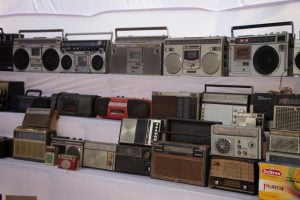Bhubaneswar: The humble radio, instead of becoming extinct, has not only survived competition from social media platforms but also growing in popularity, adding more and more listeners thanks to FM channels and Prasar Bharati’s Akashvani Kendras, whose large network now covers 99.9 per cent of the country.
In Odisha, which is often battered by cyclones, it’s the only medium for the authorities to get information to people.
Mobile phones have played a key role in radio’s growing popularity today. The cellphone is the ‘new radio set’, replacing the old radio set although still in use, as listeners tune into radio programmes on apps or other multi-function devices.
Prime Minister Narendra Modi’s ‘Mann Ki Baat’ has also pushed up the popularity of radio, sharing his thoughts with millions of Indians in urban, rural and remote areas of the country.
While FM channels have popularised the radio with their entertainment programmes and celebrity RJs, for millions of Indians, Akashvani stands for trust.
That is also the theme for World Radio Day 2022, which is celebrated on February 13 every year – ‘Radio and Trust’.
* Trust in radio journalism
* Trust and accessibility
* Trust and viability of radio stations
In Odisha also, the popularity of radio is growing. In 2007, three FM stations began broadcasting in Bhubaneswar and two in Rourkela. That number is increasing. In 2016, auction took place for one more FM channel in Bhubaneswar and two more in Rourkela.
The Centre is planning auctions for 15 more FM radio stations in Odisha — three each in five cities, Balasore, Baripada, Puri, Berhampur and Sambalpur.
That’s quite a long journey since 1948, when Odisha’s first radio station, the Akashvani Kendra in Cuttack, began functioning. The state now has 15 Akashvani Kendras. More were proposed in Sora, Angul, Rairangpur, Deogarh, Sundargarh, Paradip, Parlakhemundi, Baliguda, Nuapada and Rayagad. Many have started functioning. While the stations at Sora and Rairangpur produce and relay their own programmes, others relay programmes from other centres.
The number of community radio stations by private and educational institutions is also increasing in Odisha, which now has 21 such stations.
According to Subrat Kumar Pati, a journalist who is passionate about promoting the use of radios, “with popularity of radio growing and more stations coming up, it has also created employment opportunities. But Odisha lacks facilities to churn out skilled people to work at these stations. Besides, FM stations’ primary focus is entertainment programmes which may not attract people of all ages. These radio stations also need to focus on programmes that promote language, literature, music and culture, and spread awareness. Radio stations need to adapt to changing times as their programmes are more accessible now on mobile phones”.


Considering the popularity of radio and its reach in the state, today being World Radio Day, it’s a good occasion for the Odisha government to expedite the launch of three radio projects it had announced:
‘Apananka Pain’
This is to be Odisha Chief Minister Naveen Patnaik’s version of ‘Mann Ki Baat’. Naveen will address villagers and farmers for 10 minutes every month on ‘Apananka Pain’ (For You) in Odia. The programme is to be broadcast on ‘Biju Gaon Radio’, a community radio service proposed by the Odisha government in 2016.
‘Apananka Pain’ and ‘Biju Gaon Radio’ were proposed by Odisha University of Agriculture and Technology (OUAT) Vice-Chancellor Surendranath Pasupalak. Thirty-two ‘Krishi Vigyan Kendras’ under OUAT, which are spread across the state, will serve as the infrastructure for the community radio service.
Jagannath Temple FM service
In 2013, the Shri Jagannath Temple Administration (SJTA) in Puri announced to start an FM service to broadcast devotional songs, daily rituals, discourses on Lord Jagannath and other necessary information. The proposed project cost was around Rs 4 crore then and will function from the premises of the temple office in Puri.
Radio stations in jails
It was proposed in 2018 to start radio stations in jails, beginning with Jharpada and Choudwar and then expanding the plan to five more jails. These radio stations will give a chance to prisoners to play radio jockeys (RJs), play and listen to their favourite songs and offer an outlet to prisoners to express themselves.


